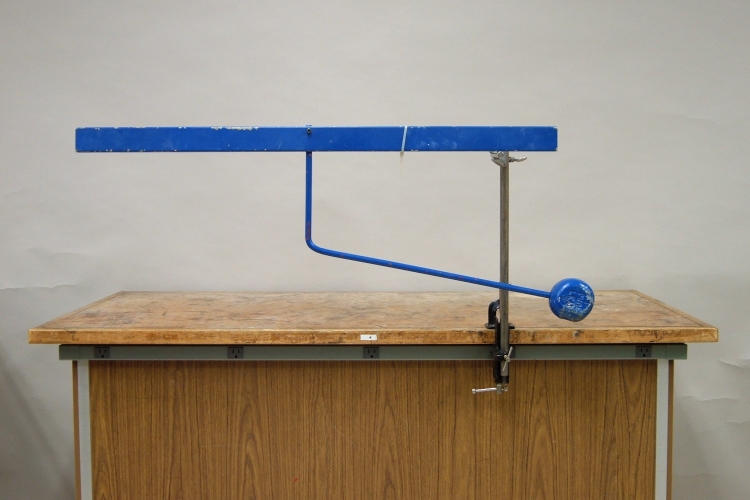
When you place the beam of this cantilever on the support rod, it balances at the position in which its center of mass lies on the vertical line that passes through the point of contact. If you set the beam at a point different from that shown above, the beam no longer rests horizontally, but the cantilever balances at some other orientation. The zip tie allows you to do this without having the beam slip on the rod.
The center of mass of an object is the weighted mean displacement of all of its mass points from some reference point, usually the origin of the coordinate system in which the object sits. This is the sum of the products of all the mass points with their distances from the origin, divided by the total mass of the object (rcm = Σmiri/M). If we set the center of mass of the object at the origin, we find that this sum equals zero. This tells us that, assuming that we could exert a force on the object at its center of mass, this would result in no torque on the object, but if we applied a force to the object at any other point, as long as the line of force did not go through the center of mass, we would exert a torque on the object about its center of mass.
If the object is relatively small, and close to the earth, then gravity acts uniformly on the object. That is, if the object is of uniform density, gravity exerts the same downward force on all of its mass points, and the sum of all of these forces is equal to a single downward force, F = Mg, acting at the center of mass of the object. The torque due to each of these forces, about the center of mass of the object, is τ = miri × g, and the sum of the torques is τ = (Σmiri) × g. If we set the center of mass of the object at the origin, this sum equals zero. Thus if we apply a force at the center of mass, that is equal to and opposite that of gravity, we can support the object without exerting a torque on it about its center of mass. This point at which the resultant force of gravity acts is also called the center of gravity. If we take the force of gravity as being uniform over the entire object, then the center of gravity and the center of mass are the same point.
If we suspend an object from any point other than the center of mass, then, we exert a torque on the object about its center of mass. Gravity, in turn, acting at the object’s center of mass, exerts an equal and opposite torque about the suspension point. Thus, if we suspend an object this way, the center of mass must lie on a vertical line below the suspension point. Demonstration 24.24 -- Clown on tightrope, provides an example of an object whose density is not uniform, and whose shape is such that the object balances when one suspends it from a point just above its center of mass. The center of mass of the clown with his balance bar lies below the wheel on which he rides; there is no material at the center of mass of the system. The cantilever in this demonstration is a more graphic example of such an object. The center of mass of the cantilever lies on the vertical line through the support point, just to the left of the upright in the photograph, somewhere between the beam and the rod by which the large round mass is attached to it (about 5 cm above the center of the rod). It is at a point where there is no material, and is actually some distance from any solid part of the object. Another example of such an object is the hoop in demonstration 28.27 -- Roll cylinders down incline. All of the mass is evenly distributed in a narrow rim, inside which there is no material. The center of mass is at the center of the hoop.
The object in this demonstration is called a cantilever, because it extends horizontally from the point at which it is supported, with no support under the extended section.
With the cantilever suspended as shown in the photograph, as noted above, the torque exerted by the support rod about its center of mass is balanced by the torque exerted by gravity about the suspension point at the center of mass. The moments on either side of the suspension point equal, and the cantilever balances with the beam resting horizontally. If you place the beam so that it rests on the support rod at some other point, gravity, acting at the center of mass, causes the beam to tilt until the center of mass lies below the new suspension point. If the angle at which the beam sits is too far from horizontal, the component of gravity that is parallel to the beam could overcome friction and cause the cantilever to slide on the support rod, and thus cause it to slide away from the balance point. A zip tie around the beam provides a stop so that when you rest the beam at a different point from that shown above, the cantilever can balance with the beam tilted from the horizontal position, and not slide away from the balance point. You can, of course, set the cantilever so that the support rod is at the corner where the rod that supports the round mass meets the beam (on the side toward the mass), and it will balance.
References:
1) Resnick, Robert and Halliday, David. Physics, Part One, Third Edition (New York: John Wiley and Sons, 1977), pp. 162-5, 283-5.